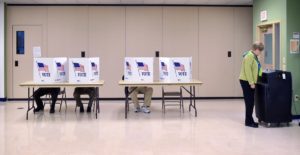By Ruby Van Dyk || Layout Assist

ant
I’d consider myself a politically aware young person. I’m a Government major, I read the news regularly, I’ve interned for multiple politicians. So, this November I was more than excited to vote.
It wasn’t my first time voting; I’d voted in 2016 in my home state of Oregon. But it was going to be my first time voting in a state that wasn’t primarily blue, where races would be tight.
Because I was so excited, I decided to register early in September. I went online, typed in my address, scanned my signature and submitted my information. I got an email that my application had been received, and that was it, or so I thought. I never received any notification that my application had any problems.
In October I still hadn’t received my voter registration card, which seemed strange to me. So I found a place to check the status of my application online and saw the address had been rejected. There was no explanation of who to contact, no explanation of what was wrong with my address, just a rejection.
When I looked at the calendar I saw that it was October 10th, a day after the deadline to register. I didn’t understand why hadn’t been notified? Why didn’t I receive an email? What was wrong with my address? It left me feeling discouraged.
As I explained my dilemma to my friends, I realized I wasn’t the only one who this had happened to. Bette Scher, a sophomore and one of my closest friends, had experienced the same thing: “A month before the deadline of voter registration, I had taken it upon myself to sign up for voting in Pennsylvania. It seemed to be pretty easy. I went through the online steps and gave all the necessary information. I was told it went through on my confirmation email and never could have known that my voter registration would be denied, without my knowledge.”
As Bette and I chatted, we discussed the fact that voting should be easy, not a series of hurdles. If it was this difficult for politically active college students with free time, imagine how it might be for a single mother of three whose first language wasn’t English? Someone who worked 80 hours as week? It didn’t seem right. Registering to vote should be straightforward.
The process shouldn’t discourage those who might already feel hesitant about the whole political process, it should be easy. Luckily, I was still able to vote by absentee ballot in my home state of Oregon, but I was still left feeling like my vote in Pennsylvania would have had more of a lasting impact.
A study out by the PEW research center indicates that a quarter of unregistered voters say that they want to vote, but they just haven’t gotten around to it yet. I found myself wondering why it had seemed so easy to vote in Oregon, but much more difficult in Pennsylvania? Others say the process is too complicated. I knew Oregon soley did vote by mail, which made it more accessible to vote, but as I researched, I realized that Oregon had enacted automatic voter registration a few years ago.
The law registered more than 225,000 new voters in 2016 based off of interactions they’d had at the DMV, like renewing a license. The special thing about the Oregon system is that it’s opt-out, not opt-in. Citizens have to indicated if they don’t want to be registered, not if they do.
Since then, many other states have adopted automatic voter registration as well, including Nevada, Vermont and California.
To me this seems like something we should adopt nationally. If we did, turnout would go up, instead of having to re-register when we moved to Pennsylvania, Bette and my registrations would have just moved with us. We should be making voter registration as simple as accessible as possible, not trying to limit it.
Sophomore Ruby Van Dyk is a Layout Assistant. Her email is rvandyk@fandm.edu.